The Dangote Refinery is an oil refinery owned by Dangote Group that was inaugurated on the 22nd of May 2023[1] in Lekki, Nigeria. When in full operation, it is expected to have the capacity to process about 650,000 barrels per day of crude oil, making it the largest single-train refinery in the world. The investment is over 19 billion US dollars.[2]
History


Nigerian businessman Aliko Dangote unveiled early plans for the refinery in September 2013, when he announced that he had secured about $3.3 billion in financing for the project.[3] At the time, the refinery was estimated to cost about $9 billion, of which $3 billion would be invested by the Dangote Group and the remainder via commercial loans, and begin production in 2016.[3] However, after a change in location to Lekki, construction of the refinery did not begin until 2016 with excavation and infrastructure preparation, and the planned completion was pushed back to late 2018.[4][2]
In July 2017, major structural construction began, and Dangote estimated that the refinery would be mechanically complete in late 2019 and commissioned in early 2020.[2] According to Reuters, citing sources familiar with the project, construction was likely to take at least twice as long as Dangote publicly stated, with partial refining capability not likely to be achieved until 2022.[2] An associated project at the site of the refinery, a urea fertilizer factory, was scheduled to begin operation in late 2018 and produce about three million tons of urea annually.[5] In 2018 the project was expected to cost up to $15 billion in total, with $10 billion invested in the refinery, $2.5 billion in the fertilizer factory, and $2.5 billion in pipeline infrastructure.[5]
In July 2022, Dangote - Nigeria's richest resident - had to borrow 187 billion naira (about 442 million USD) at 12.75% resp. 13.5% p.a. to complete the refinery.[6] Fitch Ratings noted that the refinery's start date has been postponed three times in four years and feared diminished investor confidence if operations do not begin in 2023.[6] At the same time, all of the four refineries of the state-owned oil company NNPC (in Kaduna, Port Harcourt[7] and Warri) are idle and expect to process crude oil again in 2023 after "revamping".[8]
In January 2023, the completion of the refinery's power plant was announced.[9] The inauguration is expected to take place at the end of the first quarter of 2023.[10]
In September 2023, the refinery announced that it will start producing Diesel and kerosene in October 2023 and gasoline one month later.[11]
In September, it became clear that the refinery would not yet be able to start operations because the supply of crude oil was stalling. This caused considerable public reaction.[12] On 25 November, the Financial Times gave a new date for the start of operations in December 2023, with the refinery expecting a delivery of 6 million barrels of crude oil in December, after which operations could begin. This would be the first delivery of a total of six.[13]
On Thursday, 7 December, the refinery received its first delivery of 1 million barrels of Agbami crude oil. The delivery of the Supersuez tanker OTIS did not take place in the refinery's harbour, but via "Single Point Mooring", a buoy-like floating facility for unloading liquid cargo off the coast.[14]
On Tuesday 19 December 2023, the refinery received its second cargo of 1 million barrels of crude oil.[15]
The production of Diesel fuel and aviation fuel A1 (the most common jet fuel except for the US) would start in the second week of 2024. Other fuels would be kick-started at a later time because a minimum quantity is necessary for this.[16]
Facility
The refinery is situated on a 6,180 acres (2,500 hectares) site at the Lekki Free Trade Zone, Lekki, Lagos State. It is supplied with crude oil by the largest sub-sea pipeline infrastructure of the world (1,100 km long). When fully operational it will provide 135,000 permanent jobs in the region.[17][18]
High complexity
The Dangote Oil Refinery has a Nelson complexity index of 10.5 which means that it will be more complex than most refineries in the United States (average 9.5) or Europe (average 6.5).[19] (The largest refinery in the world, the Jamnagar Refinery in India, has a complexity of 21.1.) The Nelson complexity index basically increases with the number and capacity of chemical procedures after the distillation, e.g. hydrocracking, NHT, CCR, RFCC, polymerization etc.
Among others, the refinery will run these refinery processes (please find an illustration of the chemical processes in the gallery below):[20][21][22]
| Procedure | Lines | Licensor | |
|---|---|---|---|
| Crude Distillation Unit (CDU)[23]
Input: crude oil, Output: combustible gases, naphtha (light/heavy), jet fuel, Diesel fuel, heavy oil, residue fluid Purpose: separating crude oil components by molecule length / boiling temperature |
It is the first processing step in nearly all petroleum refineries (see image below). The CDU separates the different components of crude oil by their boiling points. - In the desalter salt is being removed from the crude oil. In a single preheat train the crude oil is warmed up[24] by using heat from different procedures on this list or burning fuel from own making, like LPG.[25] After this the crude oil is heated up and led into the distilling column.
The output streams are called "cuts" (e.g. "side cut", "top cut") and those ones that are not (yet) processed further are called "straight-run" (e.g. "straight-run naphtha" as opposed to naphtha produced in other refinery processes). The main distilling column in Lekki is the biggest in the world (as of 2022) and with 112.5m height even bigger than the rocket Saturn V or the Eko Tower Black Pearl in Lagos. Generally speaking, a tall distilling column has better efficiency, better precision in separating crude oil components (less components that exit at the wrong point for example by turbulence), more exit points, and a higher throughput rate. |
1 | UOP |
| RFCC (Residue Fluid Catalytic Cracking)[28][29][30]
Input: residue fluid from CDU, air, catalyst, Output: combustible gases, flue gas, catalyst (to be re-used) Purpose: breaking molecules longer than 70 carbon atoms into shorter ones |
This cracking process converts residue fluid coming from the CDU into lighter components (see image below). The residue fluid consists of molecules with many carbon atoms (more than 70) and complex ring and branch structures. It is black, viscous, and can barely be evaporated - making it unusable as a fuel without having been "cracked".
In the reactor, the residue fluid is brought into contact with a catalyst at high temperature under near-vacuum conditions (which helps to evaporate the fluid). The catalyst in this procedure is an acidic matrix such as crystalline aluminosilicate zeolite.[31] In very simplified terms, the sharp edges of the zeolite crystals cut up the molecules of the residue fluid without themselves changing shape. However, carbon atoms attach themselves to the zeolite crystals in the RFCC process and have to be removed again in the regenerator. The cracking takes place, turning the hot fluid into gas of short-molecule compounds. After this the catalyst is recovered and regenerated. The cracked compounds are fed to a column that separates them according to their boiling point (and thus molecular length, similar to the CDU).[32] Because of the geometry of their molecules, cracking of alkanes always means
Since in RFCC no hydrogen is added, the outgoing compounds belong mostly to the olefins (ethylene, propylene, butylene, pentylene, hexylene etc.). They can be hydrotreated into alkanes (see "NHT" below), alkylated (see "Alky" below") or polymerized into e.g. polyethylene/polypropylene ("plastic"). The RFCC regenerator in Lekki has been the heaviest item on an African road, before it was installed. It also is the heaviest single piece made of metal in the world. The RFCC is one of the most safety-critical areas of a refinery. The main threat is that there must be absolutely no air in the reactor, whereas the working principle of the regenerator, to which the reactor is doubly connected, is based precisely on the supply of air. The constant challenge is not to let the hydrocarbons enter the regenerator via the two connections and not to let air enter the reactor. - In 2015, the regenerator of an Exxon refinery in Torrance, California, exploded due to lack of maintenance (the expander had worn out, a heat exchanger from a different unit was leaking combustible gases into the system and a catalyst slide valve worked insufficiently after too many years of usage) and incorrect actions after a malfunction occurred (decreasing the steam flow, installing a distance ring and "variance" from standard procedure).[33] In 2018, the Superior refinery in Wisconsin exploded, also due to a worn out RFCC catalyst slide valve.[34] |
1 | UOP |
| "Unicracking" (Hydrocracking) in mild hydrocracking mode[35]
Input: heavy oil from CDU, hydrogen Output: C4...C12 alkanes, fractionated into light and heavy naphtha, jet fuel, Diesel Purpose: breaking molecules longer than 25 carbon atoms into shorter ones |
Hydrocracking[30][36][37][38] "breaks" heavier components (molecules with more than 25 carbon atoms) in the presence of hydrogen into medium-sized molecules (4 - 12 carbon atoms per molecule).[39][40] Mild hydrocracking (MHC) is cracking with less pressure but by using a catalyst in the presence of hydrogen (the pressure is 60 to 110 bar in comparison to conventional hydrocracking at 200 bar). As a catalyst Zeolite is being used. Unlike hydrotreating, where hydrogen is used to break bonds between carbon and sulphur or carbon and nitrogen, mild hydrocracking uses hydrogen to break bonds between carbon atoms.[41][42]Safety rules must be observed here. At the Valero refinery in Delaware, two service technicians died in 2005 from nitrogen asphyxiation while trying to retrieve a roll of duct tape from the reactor, only 5 feet (1.5m) below them.[43] Other workers had previously flooded the reactor with nitrogen to remove oxygen but had not put up a specific warning. | 1 | UOP |
| Alkylation ("Alky")
Input: propylene, butylene (from RFCC), isobutane Output: isoheptane, isooctane (for blending into gasoline), butane, propane Purpose: merging short hydrocarbons into medium-sized molecules, removing olefins, improving RON (see next line in table) |
While cracking splits molecules that are too long for commercial purposes, alkylation "fuses" molecules together that are too short for commercial purposes. Specifically, we are talking about two undesirable "waste products" from the RFCC process (see above): Isobutane on the one hand and propylene or butylene on the other. They are merged into medium-length molecules with one or two branches, the so-called "alkylate", mainly isoheptane and isooctane. (The prefix "iso-" means that the molecule has "branches". In shorthand this is indicated by an added "i", e. g. iC7 for isoheptane. The suffix "-ylene" marks olefins, which are hydrocarbon molecules with one double bond between two of their atoms. They create soot when they burn.) Alkylate is a high-quality gasoline blend because it has good anti-knock properties and burns clean.
The alkylation process takes place in the presence of an acid - in the Dangote refinery, this is sulphuric acid (H2SO4). The plant is called a sulphuric acid alkylation unit (SAAU).[44] The main technology for SAAU is the STRATCO process licensed by DuPont. It is a very established technology for alkylation in refineries. In the last ten years, more than 85% of the SAAU capacity added worldwide has been produced using it. A SAAU can be divided into five major sections: reaction, refrigeration, effluent treating, fractionation, and blowdown. In the reactor, the reacting hydrocarbons are brought into contact with the catalyst sulphuric acid at a temperature of 15.6 °C (60 °F). Then the feedstocks are treated to remove impurities, especially water. The feedstock is cooled in the refrigeration section and the light hydrocarbons are discharged from the plant. Then acid, alkyl sulfates, and di-alkyl sulfates are removed from the effluent stream to prevent corrosion and fouling in the downstream process. To maintain the desired strength of spent acid, a small amount of fresh acid is continuously added to the reactor. In the fractionation section, the superfluous isobutane is recovered and the remaining hydrocarbons are separated into the desired products. The spent acid is degassed in an acid blowdown drum and the acid effluent is neutralized with caustic in a scrubber before being flared. The spent acid is stored and discharged at regular intervals. Here, too, safety rules must be observed. On 22 November 2016, a fire occurred in a refinery in Baton Rouge due to maintenance work on a 30-year-old valve that had to be operated manually. 900kg of isobutane escaped and formed an explosive gas cloud that ignited at a welding machine that was left switched on (20m away). 4 workers sustained serious burns.[45] In Philadelphia, Pennsylvania, on 21 June 2019, propane leaked from a manifold at an alkylation plant and ignited, resulting in three extremely violent explosions. This launched several pieces of equipment, including a 19-tonne container that crashed 700 m from its original location.[46] |
1 | DuPont |
| Continuous Catalyst Regeneration (CCR) Platforming[47][48][49]
Input: heavy naphtha from NHT, hydrogen Output: Toluene, Xylene (high octane gasoline components), hydrogen surplus Purpose: improving the RON of gasoline |
In high-compression engines, some fuel compounds tend to ignite before the spark plug delivers the spark. This is called "engine knocking" and is undesirable. For each component there is a measure that indicates how "knock-proof" it is: the RON or octane rating. Since naphtha has an octane rating of around 90, but modern engines require RON 95 or 98, some of the naphtha must be converted into components that have a RON of over 98 and blended into petrol. These components are the aromatic compounds ("BTX"): molecules with ring structures and double covalent bonds. They have a RON of 120 (Xylene) and 120...146 (Toluene).[50] The conversion of heavy naphtha into these aromatic compounds takes place in the CCR (see images in the gallery below). This process converts linear molecules with at least 8 carbon atoms into ring-shaped Toluene and Xylene by withdrawing hydrogen from them. Hydrogen is an important by-product of CCR and is used in other procedures on this list or can be sold for hydrogen technology.
Before entering the CCR unit, the feed of heavy naphtha has passed through the NHT, and C5, C6 and C7 have been removed. (If C7 is not removed, the CCR process produces benzene, which is both toxic and carcinogenic.) In the CCR itself, hydrogen is added at 4 to 45 atm and 495°C to 525°C. The process is highly endothermic, which requires constant re-heating between several reactor chambers. The incoming naphtha must also be free of sulphur since it damages the catalyst (this is called "nickel catalyst poisoning"). Water also damages the catalyzer as it washes out chlorides. After the chemical reaction, the stream goes into a separator which extracts excess hydrogen. After this, a stabilizing column divides the stream into lighter molecule components (methane, ethane, propane) and the high octane "reformate", similar to a distilling column.[51] Besides Dangote's CCR, the alternative, SR platforming ("semi-regenerative", "fixed-bed"), should be mentioned. However, CCR is considered to be more technically advanced (e.g. the catalyst does not wear out as quickly).[48] |
1 | UOP |
| Penex isomerization processes[52]
Input: light naphtha Output: gasoline blends with a RON of 92 Purpose: improving the RON of gasoline |
Similar to the CCR, the Penex isomerization improves the octane rating of fuel, in this case of light naphtha. In a refinery, light naphtha can come from the distillation column ("straight-run naphtha") or from other processes, for example, the cracking units. Since Bonny crude oil is a light oil, it has a high percentage of light naphtha (C5, C6, and C7). Light naphtha with 5 or 6 carbon atoms per molecule (pentane/C5, hexane/C6) has an octane rating (RON) of 50 ... 60, while gasoline at the pump station has a RON of 95 or 98. For this reason, refinery operators convert C5 and C6 into compounds with a higher RON, taking advantage of the fact that branched hydrocarbons (which begin with "Iso-" in the name) have a higher RON value than linear (so-called "normal") ones. If a molecule arranged in a row is "rearranged" so that it branches at least once, its RON value increases. This process is called "isomerization".
This process isomerizes light naphtha (pentane (nC5), hexane (nC6)) into higher-octane, branched molecules (iC5, iC6). The Penex process uses fixed-bed catalysts with chlorides. In a UOP Penex unit the feedstock passes a deisopentanizer (which extracts isopentane), then a reaction chamber with a fixed-bed catalyst, then a deisohexanizer (which extracts isohexane) and finally a Molex technology column. The end product has a RON of ca. 92. An isomerization unit is also safety critical. 2005, in Texas City, the distilling column of a isom unit erupted and then ignited, killing 15 employees and injuring 180 people.[53] This happened due to a faulty measuring instrument as well as overworked and underqualified personnel. It is the worst accident the US Chemical Safety Board has investigated. |
1 | UOP |
| Merox treatment
("Sweetening") Input: sulphides (corrosive, foul smell) in jet fuel or combustible gas Output: di-sulphides (harmless, smell of garlic, onions or not at all) to be fractionated out, hydrogen Purpose: removing corrosive sulphide compounds |
Sulphur compounds in crude oil are a big problem for operators of refineries, even if the crude oil is low in sulphur, like Bonny oil. These sulphuric compounds are called "mercaptans" and cause so-called "fouling": in continuous operation, the sulphur decomposes all metallic objects with which it comes into contact and deposits elsewhere together with soot and rust as plaque on the inside of pipes, e.g. heat exchangers - leading to blockages and leaks. (In 2012, a pipe of the CDU in the Chevron refinery in Richmond, California, burst and caused a serious fire. The carbon steel of the lining had eroded due to sulphur in the sidecut product from the CDU.[54]) Operators of refineries, therefore, try to eliminate sulphur from their products, even if legal regulations do not stipulate this in this form - for example for kerosene or LPG gas. (1997, during the era of dictator Abacha, "foul fuel" was sold at Mobil and National Oil gas stations in Nigeria.[55] The bad fuel was poisonous for humans and animals and damaged the engines of the cars. Concluding from the description, this was most certainly caused by the mercaptans in the fuel, which had not been removed.) - In the Merox process, the highly corrosive sulphides are converted into the harmless di-sulphides - a process also known as "sweetening" because (at least the larger-molecule) di-sulphides do not have the foul ("rotten eggs"/"rotten vegetables") odour of sulphides (the shorter molecule di-sulphides smell like garlic or onions). Each sulphur atom is thereby bonded to another sulphur atom and thus largely ineffective against metals. Disulphides resemble, in a very simplified way, two snakes (sulphides) that bite into each other, subsequently cannot let go and are safely eliminated together. - This is achieved by adding caustic soda or ammonia. The lye removes a hydrogen atom from the sulphur atom in the sulphide, after which it bonds to a hydrogen-free sulphur atom of another sulphide molecule. Di-sulphide molecules are therefore almost twice as long as sulphide molecules (see image below), have a higher boiling temperature and can thus be easily fractionated out of the product.[56][57] | UOP | |
| Naphtha Hydrogen Treatment (NHT, "Hydrotreatment" or "Hydrodesulfurization")[58][59]
Input: Naphtha from CDU with sulphur and nitrogen contaminations, hydrogen Output: light naphtha for Penex, heavy naphtha for CCR, ammonia, hydrogen sulphide Purpose: removing sulphur or nitrogen components and olefins from gasoline blends (mainly) |
Naphtha is a mixture of short but fluid hydrocarbon molecules (5 to 15 carbon atoms per molecule), some of which have inclusions of sulphur or nitrogen or have undesirable double bonds between two atoms (olefins). Some of it comes from the CDU ("straight-run naphtha") or from other processes in the refinery. In this procedure, naphtha reacts with hydrogen in the presence of a catalyst like cobalt-molybdenum (or nickel-molybdenum for low-sulphur crude oil) at relatively high temperatures and moderate pressures. (Reactor conditions for a naphtha hydrotreater unit are around 205-260˚C with a 25-45 bar pressure.[58]) NHT converts olefins (like hexylene), nitrogen, oxygen, metals and sulphur compounds into products, which can be utilized in other processes.[60] The main purpose of the NHT is to remove sulphur and nitrogen (see images in the gallery below). In a combustion engine, these fuel contaminations turn into NOx and SOx and are harmful to human health and the environment. Sulphur and nitrogen compounds in naphtha can also deactivate the catalyst in reforming procedures like CCR and therefore must be removed prior to catalytic reforming.
NHT consists mainly of a heater, a hydrogen injector, a fixed-bed reactor, and a separator column, in which the desulfurized naphtha and gases like hydrogen and hydrogen sulfide are divided (see image in the gallery below). - The last section of NHT can be a "slide stripper". The slide stripper separates ("strips") light naphtha (pentanes, hexanes) from heavy naphtha.[59] The light naphtha goes to the Penex unit to be isomerized. The slide stripper consists mainly of a stripping column and a reflux drum.[60] Like the RFCC, the NHT is a safety-critical area of a refinery. 2010 the NHT heat exchanger of the Tesoro refinery in Anacortes ruptured, causing an explosion and killing 7 workers. The heat exchanger had suffered long-term effects of "high-temperature hydrogen attack".[61] The maintenance staff had ignored the leaking of the heat exchanger before the explosion, considering it to be "normal".[61] |
1 | UOP |
| Naphtha splitter column | It splits hydrotreated naphtha into light and heavy naphtha, very similar to a distilling column or CDU (see above).[62] While the Dangote refinery lists this column as a separate unit, it probably is identical to the "slide stripper" mentioned in section "Naphtha hydrogen treatment" further up in this table. | ||
| Diesel Hydrotreatment (DHDT)
Input: C9...C24, hydrogen Output: C9...C24, hydrogen sulphide Purpose: removing sulphur and nitrogen components from Diesel |
Diesel Hydrotreatment (DHDT) removes impurities like sulphur and nitrogen from diesel oil in the presence of a catalyst and hydrogen converting it into diesel fuel.[63] Diesel fuel has 9 to 24 carbon atoms per molecule (C9 ... C24), while petrol has 4 to 12 carbon atoms per molecule (C4...C12).[60] Diesel oil also has a higher sulphur content than naphtha. The process of hydrotreating diesel oils is similar as but much more complex than NHT, primarily due to the addition of the regenerative amine system, which recovers excess hydrogen gas and removes hydrogen sulfide via diethanolamine (DEA).[59] | ||
| SCANfining
Input: Sulphur-rich naphtha from the RFCC or MHC Output: naphtha Purpose: removing sulphur components |
Naphtha is not only produced during distillation in the CDU ("straight-run naphtha") but also during cracking (RFCC and MHC). This naphtha from cracking is particularly rich in sulphur. To protect the refinery from harmful sulphur compounds and to comply with international quality regulations, they must be removed. The above-mentioned naphtha hydrotreatment is cost-intensive and not very efficient with high sulphur content like in FCC-naptha. This is why the SCANfining process was developed in 1994. It is a low-pressure process and therefore, depending on the existing economic factors, not as capital-intensive as hydrotreatment (NHT).[64] In addition, it does not affect other properties of the naphtha (such as olefin content, nitrogen content, etc.) as much as NHT. It is therefore a more "selective" process for sulphur removal than NHT.[65] SCANfining (Selective Catalytic Naphtha hydrofining) uses an Al2O3 catalyst (RT-225) with a low metals content and high dispersion. | EMRE (Exxon) | |
| LPG Splitter | Propane-Propylene (PP) Splitters transform Liquefied Petroleum Gas (LPG) to the heavier Polymer Grade Propylene (PGP) and the lighter propane by using thermocompression.[66] At a pressure of 11 bar and 34oC, propylene is gaseous and propane is liquid. The mixture is brought to this state in a distillation column, with propylene collecting at the top and propane at the bottom. The derived propylene has a purity of 99.5%, which corresponds to the highest quality level "Polymer Grade Propylene" (PGP).[67] The propane has a purity of over 90%. | ||
| FCCG desulfurization treatment[68] | Flue gas treatment reduces the number of pollutants produced from the combustion of fossil fuels. It can contain pollutants such as particulates, mercury, sulfur dioxide and carbon dioxide.[69] | 1 | EMRE (Exxon) |
| Butamer process[70][71] | There is only a limited market for butane as it comes from the CDU. Isobutane, on the other hand, is used in the alkylation process to produce alkylate and is therefore a blending component of petrol used at the pump. Isobutane is therefore commercially more interesting than butane.
In the Butamer process (Butane isomerization), butane is therefore converted into isobutane. In principle, it is similar to the Penex process, but it involves gases rather than liquids. The Butamer process is a high-efficiency, cost-effective means of isomerizing normal butane (nC4) to isobutane (iC4).[72] |
1 | UOP |
| Sulphur recovery[73] (SRU) | SRU recovers sulfur-containing, poisonous acidic gas. The most commonly used process is the Claus Process, in which the incoming gas burns with oxygen and is refrigerated. This recovers sulfur from the burnt gas.[74] | 2 | Jacobs |
| Hydrogen plant | It usually consists of a Steam Methane Reformer (SMR) and a hydrogen purification system. Preheated natural gas (or Refinery Off Gas) is introduced across a catalyst to produce a 75–80% hydrogen stream, then is puried (by a MEA scrubber or a PSA unit) to produce 99% pure hydrogen.[75] | 2 | Air Liquide |
| Polymerization | Polypropylene and polyethylene are the two most well known commodity plastics produced through the polymerization of propylene/ethylene with catalysts.[76] | 2 | INEOS |
| Gas plant[77]
Input: combustible gas from the CDU or RFCC, Output: LPG gas, propane, butane |
The gas plant extracts the heavier and more valuable gases out of gas coming from the distillation units and other process units. There are two types of gas plant. A saturated gas plant treats gas streams that contain only saturated hydrocarbons (mainly methane, ethane, propane and butane). An unsaturated gas plant treats gas from cracking units (RFCC, hydrocracking, coker) that contains unsaturated hydrocarbons (olefins / alkenes like propene / propylene and butene / butylene).[78]
The gas plant leads the more valuable heavy components back into product blending or to conversion and sends the lighter and less valuable gases to the refinery fuel system where they are burned for heating processes like in the endothermic CCR platforming / reforming. The gas plant consists of a number of process units like:[78]
|
Further units are:
- MECS® sulphuric acid regeneration (SAR) unit for recovering the sulphuric acid from the alkylation unit (see above),[81]
- the MECS® DynaWave® sulphur recovery unit, "reverse jet wet gas scrubber technology offers superior air pollution control by combining multiple functions into a single vessel, with high reliability, low maintenance and operational costs",[82]
- and the BELCO® EDV® wet scrubbing system for sulphur compounds in flue gas from the RFCC (see above).[83]
Superlatives
The Dangote refinery will be the seventh-largest oil refinery in the world (as of 2023, see here).
In 2019, the world's largest crude distillation column, weighing 2,350 tonnes, was installed in place at the Dangote refinery by a specialist Dutch company.[84] With a height of 112 metres it is slightly taller than the Saturn V rocket which brought the first man to the moon (110.6m) and 16 metres taller than Big Ben. In the same year, three more records were set when the world's heaviest refinery regenerator was installed[85][86] - having already been the "heaviest item ever to be transported over a public road in Africa" at a stately 3,000 tonnes and also being "the heaviest single piece of steel structure" of the world.[87][88]
Marine facilities
The self sufficient marine facility has the ability for freight optimization. To the marine facilities belong:[89]
- 2 crude SPM (single point mooring, see image below) for unloading ships from Aframax to ULCC (ultra-large crude carrier)
- 3 product SPM for product exports up to Suezmax vessels
- 2 subsea crude pipelines (diameter 48" or 1.22 metres) with interconnection
- 4 subsea pipelines for products and imports (diameter 24" or 0.61 metres)
- ca. 120km subsea pipeline
Targeted performance
With a single crude oil distillation unit, the refinery will be the largest single-train refinery in the world.[2]
At full production, the facility will process about 650,000 barrels of crude oil daily, transported via pipelines from oil fields in the Niger Delta, where natural gas will also be sourced to supply the fertilizer factory and be used in electrical generation for the refinery complex.[90][5] This corresponds with 50,000,000 litres (13,000,000 US gal) of Euro-V quality gasoline and 17,000,000 litres (4,500,000 US gal) of diesel daily, as well as aviation fuel and plastic products.[5] With a greater capacity than the total output of Nigeria's existing refining infrastructure, the Dangote Refinery will be able to meet the country's entire domestic fuel demand, as well as export refined products.[90]
Gallery
 Crude oil distillation unit (working principle)
Crude oil distillation unit (working principle) Simplified production flow chart of the Dangote refinery
Simplified production flow chart of the Dangote refinery The CDU distilling/distillation column in comparison to the largest Eko Tower and a Saturn V rocket
The CDU distilling/distillation column in comparison to the largest Eko Tower and a Saturn V rocket Regenerator in comparison with the Cathedral Church of Christ in the center of Lagos, Nigeria
Regenerator in comparison with the Cathedral Church of Christ in the center of Lagos, Nigeria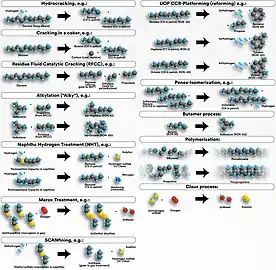 Chemical procedures at the Dangote refinery (black globes: carbon atoms, hydrogen in light blue)
Chemical procedures at the Dangote refinery (black globes: carbon atoms, hydrogen in light blue) Sulphuric acid alkylation process (simplified), STRATCO procedure, SAAU; Line width corresponds approximately to the mass flow
Sulphuric acid alkylation process (simplified), STRATCO procedure, SAAU; Line width corresponds approximately to the mass flow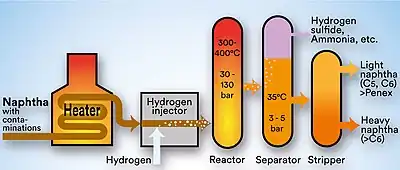 NHT - Naphtha Hydrogen Treatment
NHT - Naphtha Hydrogen Treatment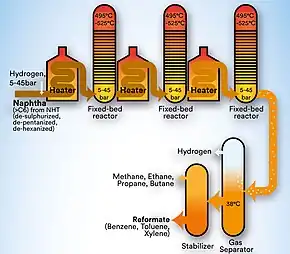 Continuous Catalytic Reforming in the reforming/platforming unit
Continuous Catalytic Reforming in the reforming/platforming unit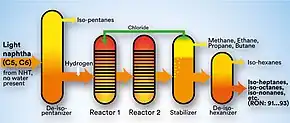 UOP Penex unit
UOP Penex unit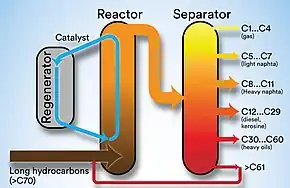 Mass flow of the Residue Fluid Catalytic Cracking (RFCC) unit
Mass flow of the Residue Fluid Catalytic Cracking (RFCC) unit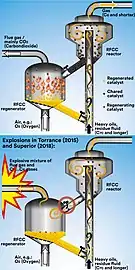 RFCC procedure in a refinery using a catalyst; below: how the explosions in Torrance and Superior occurred
RFCC procedure in a refinery using a catalyst; below: how the explosions in Torrance and Superior occurred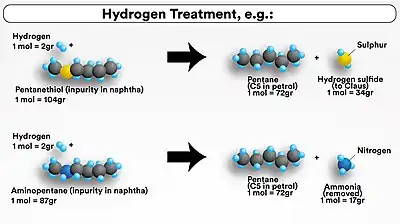 Naphtha Hydrogen Treatment
Naphtha Hydrogen Treatment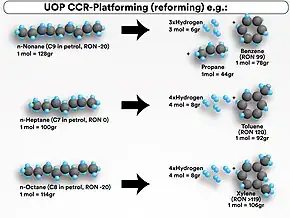 Continuous Catalytic Reforming (CCR)
Continuous Catalytic Reforming (CCR) Alkylation procedure (simplified)
Alkylation procedure (simplified)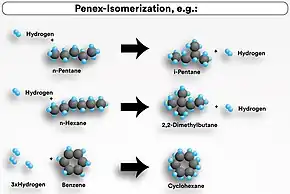 UOP Penex process[91]
UOP Penex process[91]
 Distillation column at Dangote refinery
Distillation column at Dangote refinery Single point mooring (here: in Kochi, India)
Single point mooring (here: in Kochi, India)
References
- ↑ "Buhari finally inaugurates Dangote refinery". 22 May 2023.
- 1 2 3 4 5 "Billionaire's huge Nigerian oil refinery likely delayed until 2022: sources". Reuters. 10 August 2018. Retrieved 13 October 2018.
- 1 2 "Nigeria's Dangote signs deal to build oil refinery". BBC News Online. 4 September 2013. Retrieved 13 October 2018.
- ↑ "Can this massive refinery solve Nigeria's energy crisis?". CNN Money. 6 June 2016. Retrieved 13 October 2018.
- 1 2 3 4 "A $15 Billion Oil Bet Is Tough Challenge for Richest African". Bloomberg Businessweek. 13 July 2018. Retrieved 13 October 2018.
- 1 2 Diala, Sam; THEWILL (2022-07-21). "Dangote Borrows N187.6bn for Refinery Completion". Retrieved 2022-08-06.
- ↑ "Port Harcourt refinery to start operation next year The Nation Newspaper". 2022-04-15. Retrieved 2022-08-06.
- ↑ Sadiq, Lami (2021-02-24). "Nigeria: Kaduna Refinery to Resume Operations Q1 2023". allAfrica.com. Retrieved 2022-08-06.
- ↑ Dangote Petrochemical Refinery Power Plant Finally Completes, retrieved 2023-01-05
- ↑ Clement, Philip Shimnom (2023-01-17). "FACT CHECK: Is Dangote refinery due for commissioning Jan 24?". Daily Trust. Retrieved 2023-01-18.
- ↑ Mitchell, Charlie (2023-09-18). "INTERVIEW: Nigeria's colossal Dangote refinery to start operating in October at 370,000 b/d". www.spglobal.com. Retrieved 2023-10-19.
- ↑ Board, Punch Editorial (2023-09-27). "NNPC, supply crude to local refineries". Punch Newspapers. Retrieved 2023-12-01.
- ↑ "Africa's richest man under pressure as giant refinery nears production". www.ft.com. Retrieved 2023-12-01.
- ↑ Aduloju, Bunmi (8 December 2023). "Dangote refinery receives 1m barrels of crude, to get second shipment in 3 weeks". The Cable. Retrieved 2023-12-08.
- ↑ Akpan, Udeme. "$19bn Dangote Refinery gets another 1m barrels crude oil". The Cable. Retrieved 2023-12-20.
- ↑ "Dangote's diesel and JetA1 to hit market early 2024". The Herald. Retrieved 2023-12-12.
- ↑ "Dangote Refinery to create 135,000 direct jobs, 100,000 indirect jobs and fetch FG over $500m in 3 years —Ambode". News Express Nigeria Website. Retrieved 2022-12-08.
- ↑ Odinaka; Odinaka (2016-06-27). "Dangote Refinery to Create 235,000 Jobs - VP Osinbajo Visits Multi-billion Naira Project in Lagos (Photos)". Tori.ng. Retrieved 2022-12-08.
- ↑ Maples, Robert E. (2000). Petroleum Refinery Process Economics (2nd ed.). Tulsa, Oklahoma: Pennwell Pub. ISBN 9780878147793.
- ↑ "Honeywell awarded equipment contract for Dangote's largest single-train refinery". www.constructionboxscore.com. Retrieved 2022-06-14.
- ↑ Treese, Steven A; Pujadó, Peter R; Jones, David S. J, eds. (2015). Handbook of Petroleum Processing. Springer. doi:10.1007/978-3-319-14529-7. ISBN 978-3-319-14528-0.
- ↑ Petroleum refining processes explained simply, retrieved 2022-06-15
- ↑ Crude Distillation Unit, retrieved 2022-06-16
- ↑ "How to Get the Best From Your Preheat Train a UK Refinery Based Case Study". www.aiche.org. 2013-04-29. Retrieved 2022-06-23.
- ↑ Wilson, Ian. "Mitigation of Crude Oil Refinery Heat Exchanger Fouling Through Retrofits Based on Thermo-Hydraulic Fouling Models". Researchgate. Retrieved 23 June 2022.
- ↑ Axens. "CDU (Crude Distillation Unit)". axens.net. Retrieved 2022-06-18.
- ↑ "How stuff works: asphalt". Deseret News. 2010-08-14. Retrieved 2022-12-05.
- ↑ Fluid Catalytic Cracking Unit Overview FCCU, retrieved 2022-06-15
- ↑ Fluid Catalytic Cracking, retrieved 2022-06-15
- 1 2 C.2.2 - Compare catalytic cracking, thermal cracking and steam cracking, retrieved 2022-06-15
- ↑ "Optimisation of product yield and coke formation in a RFCC unit". www.digitalrefining.com. Retrieved 2022-06-30.
- ↑ "Optimisation of product yield and coke formation in a RFCC unit". www.digitalrefining.com. Retrieved 2022-06-18.
- ↑ Animation of 2015 Explosion at ExxonMobil Refinery in Torrance, CA, retrieved 2022-07-02
- ↑ Animation of April 26, 2018, Explosion and Fire at the Husky Energy Refinery in Superior, Wisconsin, retrieved 2022-07-02
- ↑ Clarke, Ian. "UOP Hydrocracking Technology - Upgrading Fuel Oil to Euro V Fuels" (PDF). VCM Study. Retrieved 2022-06-16.
- ↑ "What is Hydrocracking? - Definition from Corrosionpedia". Corrosionpedia. Retrieved 2022-06-15.
- ↑ "Chinese Refiner to Use Honeywell UOP Unicracking". uop.honeywell.com. Retrieved 2022-06-15.
- ↑ Hydrocracking, retrieved 2022-06-15
- ↑ Bhatia, Subhash (1989-12-21). Zeolite Catalysts: Principles and Applications. CRC Press. ISBN 978-0-8493-5628-5.
- ↑ Jones, David S. J.; Pujadó, Peter R.; Pujadó, Peter P. (2006-01-11). Handbook of Petroleum Processing. Springer Science & Business Media. ISBN 978-1-4020-2819-9.
- ↑ TOPSOE. "Hydrocracking | Mild hydrocracking". www.topsoe.com. Retrieved 2022-06-19.
- ↑ "IsoTherming® Technology for Mild Hydrocracking". Elessent Clean Technologies. Retrieved 2022-06-19.
- ↑ CSB Safety Video: Hazards of Nitrogen Asphyxiation, retrieved 2022-07-11
- ↑ "Alkylation unit". www.mckinseyenergyinsights.com. Retrieved 2022-07-27.
- ↑ Animation of Fire at ExxonMobil's Baton Rouge Refinery, retrieved 2022-07-12
- ↑ Preliminary Animation of Philadelphia Energy Solutions Refinery Fire and Explosions, retrieved 2022-07-18
- ↑ PFD of a catalytic reforming Unit, retrieved 2022-06-23
- 1 2 UOP Platforming Process, retrieved 2022-06-23
- ↑ "Continuous Catalytic Reforming (CCR)". www.chromalox.com. Retrieved 2022-06-15.
- ↑ Kanellopoulos, Nick (2015). Small-Scale Gas to Liquid Fuel Synthesis. Boca Raton, FL: CRC Press. p. 431. ISBN 978-1466599390.
- ↑ "Fifty years of CCR platforming". www.digitalrefining.com. Retrieved 2022-06-18.
- ↑ "Isomerization Process". Hassan ElBanhawi. 16 August 2017. Retrieved 2022-06-15.
- ↑ Updated BP Texas City Animation on the 15th Anniversary of the Explosion, retrieved 2022-10-01
- ↑ Animation of Fire at Chevron's Richmond Refinery, August 6, 2012, retrieved 2023-10-20
- ↑ "TIMELINE: Bad fuel, foul fuel, off-spec -- Nigeria's history with bad petrol". TheCable. 2022-02-10. Retrieved 2023-10-19.
- ↑ GmbH, KROHNE Messtechnik. "Merox treatment in the oil & gas industry". krohne.com. Retrieved 2022-08-08.
- ↑ "Merox". www.mckinseyenergyinsights.com. Retrieved 2022-08-08.
- 1 2 "Naphtha hydrotreater - oil refinery - Naphtha hydrotreater". www.prelectronics.com. Retrieved 2022-06-16.
- 1 2 3 "Naphtha Hydrotreating Unit". EnggCyclopedia. 2012-02-11. Archived from the original on 2022-09-30. Retrieved 2022-06-16.
- 1 2 3 "An Overview of Hydrotreating". www.aiche.org. 2021-09-23. Retrieved 2022-06-18.
- 1 2 Animation of Explosion at Tesoro's Anacortes Refinery, retrieved 2022-07-02
- ↑ "544 tons naphtha splitter successfully relocated". www.hydrocarbonprocessing.com. 21 October 2019. Retrieved 2022-06-18.
- ↑ "Hydrocracker Unit (HCU) | Diesel Hydrotreating (DHT)". yesyen.com. Retrieved 2022-06-19.
- ↑ "Selective FCC naphtha desulphurisation". www.digitalrefining.com. Retrieved 2023-12-14.
- ↑ "ExxonMobil's SCANfining Technology Selected for Three Low Sulfur Gasoline Projects for Sunoco, Inc. | Exxon Mobil Corporation". ir.exxonmobil.com. Retrieved 2022-06-24.
- ↑ "Getting the most from your propane-propylene (PP) splitter unit | Aggreko". www.aggreko.com. Retrieved 2022-06-18.
- ↑ Aggreko (2021-09-21). "Unconventional Improvement of Propylene Recovery Yield at the PP Splitter". Asian Downstream Insights. Retrieved 2023-12-14.
- ↑ "Kashima Refinery - A Barrel Full". abarrelfull.wikidot.com. Retrieved 2022-06-16.
- ↑ "Flue Gas Treatment Systems Market Size Share Growth Opportunities and Forecast 2022". DataMIntelligence. Retrieved 2022-06-18.
- ↑ "Butamer process". TheFreeDictionary.com. Retrieved 2022-06-15.
- ↑ TechStar. "Refining - Butamer Process". info.techstar.com. Retrieved 2022-06-15.
- ↑ "UOP BUTAMER". pdfcoffee.com. Retrieved 2022-06-18.
- ↑ admin (2022-01-29). "Sulfur Recovery Unit". OilGasPedia. Retrieved 2022-06-16.
- ↑ "Sulfur Recovery Unit (SRU) In Refinery, Claus Process Plant Design Engineering". Peiyang Chemical Equipment Co., Ltd. Retrieved 2022-06-18.
- ↑ Emerson. "Refining Process Solution Guide" (PDF). www.emerson.com. Retrieved 2022-06-18.
- ↑ "Polypropylene | INEOS Polymers". www.ineos.com. Retrieved 2022-06-18.
- ↑ www.setlab.com http://www.setlab.com/resources/refining/gas-plants/#1498508139597-fcd50a18-144e. Retrieved 2022-06-15.
{{cite web}}: Missing or empty|title=(help) - 1 2 3 "Gas plant". www.mckinseyenergyinsights.com. Retrieved 2022-06-14.
- ↑ "Fat oil". www.mckinseyenergyinsights.com. Retrieved 2022-06-26.
- ↑ www.setlab.com http://www.setlab.com/resources/refining/gas-plants/#1498508139597-fcd50a18-144e. Retrieved 2022-06-18.
{{cite web}}: Missing or empty|title=(help) - ↑ "Spent sulphuric acid regeneration (SAR) process". www.digitalrefining.com. Retrieved 2023-12-15.
- ↑ "MECS® Process Technologies - Ecosystems Europe". Retrieved 2023-12-15.
- ↑ "Controlling FCCU emissions: 
EDV Wet Scrubbing". www.digitalrefining.com. Retrieved 2023-12-15.
- ↑ Monumental Milestone at Dangote, retrieved 2022-06-13
- ↑ Odeleye, Femi. "Dangote Refinery's RFCC Unit Gets Installation Of World's Heaviest Regenerator". www.plat4om.com. Retrieved 2022-06-13.
- ↑ Dangote Refinery - A Game changer!, retrieved 2022-06-14
- ↑ Mammoet. "Mammoet sets a new record in Nigeria". www.mammoet.com. Retrieved 2022-06-13.
- ↑ Creating a solid foundation for economic development: Dangote Refinery, retrieved 2022-06-13
- ↑ Dangote Refinery, retrieved 2022-06-16
- 1 2 "In Nigeria, Plans for the World's Largest Refinery". The New York Times. 9 October 2018. Retrieved 13 October 2018.
- ↑ "Isomerization Process". Hassan ElBanhawi. 16 August 2017. Retrieved 2023-03-05.
- ↑ "Mammoet moves 3000-tonne regenerator for Dangote refinery".
- ↑ "Installation of World Heaviest Regenerator, RFCC Unit at Dangote Refinery (Photos)".
- ↑ "Mammoet Meets Land Reclamation Challenges on Dangote Refinery Project – Heavy Lift News".